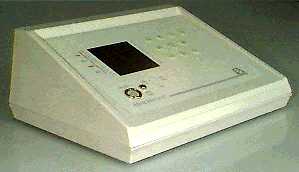Mind Mirror III

The Real-time Brain Wave Spectrum Analyzer.
Key Characteristics
- Small portable EEG
- Easy connection to supplied EEG electrode harness
- Displays and stores on a PC based computer through an electrically isolated fibre optic modem.
The Mind Mirror series of instruments has pioneered the discovery of brain
states and
their relation to subjective states of mind.
The Mind Mirror III is a standalone EEG, designed
to show visually the presence of Alpha, Beta, Theta and Delta. This is displayed
in a unique format as two arrays on a Liquid Crystal Display or a PC CGA screen.
Each array
shows independently
and simultaneously the electrical activity in the left and right hemispheres
of the brain
in the area of the electrodes. Every subtle change is clearly shown.
The Mind Mirror III hasthe following features:-
- 15 Bargraph outputs per hemisphere
- Session Recording - At the touch of a button the Mind Mirror III
starts recording the display. Another button allows the session to
be reviewed. - Computer Communications - A recorded session can be sent to a
computer using the supplied cable. Optionally the display can be
sent as it is happening to a computer using a fiber optic cable. - EMG Activity - A separate bargraph is devoted to monitoring
muscle tension on each side of the head
Mind Mirror III Specification
The Mind Mirror III is a twin channel electroencephalograph (EEG) which performs instant frequency analysis and displays the results on horizontal barographs on an LCD. Expanding barographs moving right show the magnitude of the signal in the right hemisphere, and barographs moving left show the magnitude of the signal in the left hemisphere. Each bargraph represents the output of one filter.
The barographs are centered on the following frequencies: 0.75Hz, 1.5Hz, 3Hz,
4.5Hz, 6Hz, 7.5Hz, 9Hz, 10.5Hz, 12.5Hz, 15Hz, 19Hz, 24Hz, 30Hz and 38Hz. The
bandwidth of each bargraph is adjusted so that the 3db loss points coincide
with the equivalent points of the adjacent filter. A separate EMG bargraph
displays the magnitude of frequencies in a 100 to 200Hz window. EEG filter
frequencies can be supplied to custom specifications on request.
Maximum input sensitivity is 3 microvolts. The wideband noise is less than
1 microvolt. The sensitivity may be switched between 3, 5, 10, 30, 50 or 100
microvolts rms. The CMR response is better than 60db. A built in test oscillator
checks the performance of the Mind Mirror III and when connected to a subject,
is used to check the quality of the head contact. The test signal level is
approximately 100 microvolts and cannot harm the subject.
The last 30 minutes of use is automatically recorded and can be sent after
the session to an MS-DOSŪ computer. This uses a supplied cable terminating
in an RS232 9 pin D type connector. For safety reasons the electrodes and computer
cable use the same socket and can't be plugged in together. Real-time communications
uses a fiber optic lead which plugs into the back of the unit and terminates
in an RS232 9 pin D type connector.
The Mind Mirror III uses a microprocessor to process the signal and then display
them on the LCD.
The instrument is battery operated so that the subject is in no danger of electrocution.
The Mind Mirror III is housed in an attractive hard white plastic unit with
a sloping front panel for ease of use, measuring254mm wide x 127mm deep x 107mm
high.
A carrying case containing the Mind Mirror III, head band, harness, electrodes,
one tube of jelly and an off-line computer cable is supplied with the unit.
The carry case measures 47cm wide x 34cm deep x 18cm high.